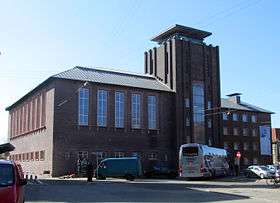Spanien Public Baths
| Spanien Public Baths | |
|---|---|
| Badeanstalten Spanien | |
|
Badeanstalten Spanien | |
| General information | |
| Architectural style | Functionalism |
| Location | Aarhus, Denmark |
| Construction started | 1931 |
| Completed | 1933 |
| Inaugurated | 15 September 1933 |
| Technical details | |
| Floor count | 4 |
| Floor area | 5,984 m2 (64,410 sq ft) |
| Design and construction | |
| Architect | Frederik Draiby |
| Website | |
| Aarhus Municipality Website for Spanien | |
Spanien Public Baths (Danish: Badeanstalten Spanien), colloquially known simply as Spanien, is a public bath house and a listed building in Aarhus, Denmark. The bath house was completed in 1931 and was listed on the Danish national registry of protected buildings and places by the Danish Heritage Agency on 15 February 1989.[1]
History
In 1926, the at the time only public bath house in Aarhus closed and it was decided that a new one was to be built on an available lot on the street of Spanien. The project was budgeted at 750,000 Danish Kroner. Construction commenced in 1931 and was completed in 1933 but at a cost twice as high as initially projected. The finished building included an Olympic-size swimming pool, public showers on the ground floor, a luxury department on the 3rd floor, restaurant, hairdresser and other facilities.[2]
Spanien was constructed with the newest technology in mind. There was a system to create artificial pine-scented rain, underwater lighting, heated floors surrounding the pools, seawater was piped from the condensers of the nearby power plant, in the saunas chairs made of steel pipes were water cooled and every department had a phone line. The technological solutions drew much attention at the time and some 60,000 visitors, mainly from Jutland, came to see the new state of the art bath house and pool.[2]
In the 1930s, the swimming pool was frequently used for international competitions and numerous world records were set there. Prominent local swimmers at the time was Kirsten Busch-Sørensen, Fritze Nathansen og Eva Arndt.
Architecture and design

Spanien Public Baths is a massive four story building with a six story tower. The walls are of red bricks topped with a plated copper hip roof. The tower has a flat copper plated roof. The building is an example of Danish functionalism with traditional Danish materials mixed in a spartan, clean style. The large main building is mostly free of decorations in the spirit of functionalism but the tower features flat brick columns reminiscent of classical pilastres. The interior is painted very colorful, breaking stylistically with the simple exterior and communicating the purpose of various areas and spaces.[2]
Facilities
The facilities were initially designed both to cater to the needs of the many working class citizens who lived without heated water and bathrooms in their city homes, and as a wellness facility for wealthier citizens. In modern times, there is no longer the same imminent need to cater for basic hygienic needs of the citizens so it was decided to thoroughly renovate and redesign the buildings. This project was realised between 2012 and 2014.[3][4]
There is today a 25 meter exercise and fitness pool, pools for children and toddlers, saunas and spas. The 3rd floor contains a wellness unit with an ice water pool, saunas, spa baths and massage pools.[5]
See also
References
- ↑ "BADEANSTALT" (in Danish). Danish Heritage Agency. Retrieved 22 January 2016.
- 1 2 3 "Badeanstalten Spanien" (in Danish). Danish National Archives. Retrieved 22 January 2016.
- ↑ "Grossererbadet" (in Danish). Aarhus Municipality. Retrieved 22 January 2016.
- ↑ "Badeanstalten åbneri Spanien" (in Danish). Århus Stiftstidende. Retrieved 22 January 2016.
- ↑ "Grossererbadet" (in Danish). Aarhus Municipality. Retrieved 22 January 2016.
External links
Coordinates: 56°09′06″N 10°12′40″E / 56.1517°N 10.2110°E

